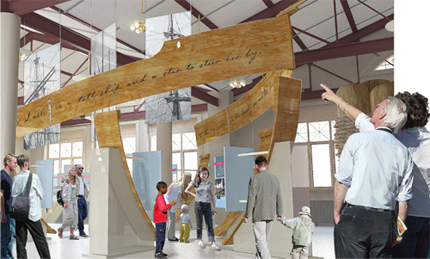
It was a landing made a million times over in the last dozen decades.
A small ferry puttered across New York harbor just after noon yesterday, diesel fumes wafting over the deck, bobbing in the wake of larger ships. A few gulls and cormorants saw the boat off, a gaggle of tourists greeted them across the water, looking down from the parapet of Ellis Island. Leading the pack of politicians, administrators, and reporters was 12 Americans-to-be, arrayed variously in combat fatigues, dress uniforms, and rumpled suits.
These dozen foreigners in waiting were the symbol within a symbol within a symbol. The Statue of Liberty–Ellis Island Foundation had gathered them together for the unveiling of The Peopling of America Center. Until now, the museum had been a monument to the 12 million who had arrived on this tiny island off the tip of Manhattan, but the new center would expand the museum into a celebration of all American immigration—even transforming the museum’s name. It would now be known as Ellis Island: The National Museum of Immigration, and these 12 were to be its first inductees.
“When we restored the buildings at Ellis Island in the 1980s and installed the museum in 1990, some people came through and said, ‘Well, there’s nothing here for me,’” Stephen Briganti, president of the foundation, told AN before an unveiling ceremony of the new exhibit halls. “The story of America, of American immigration is so much more than just white Europeans, and increasingly so. Ellis Island is a symbol of inclusion. It’s a symbol of diversity. We thought we should tell the entire story.”
The new exhibit spaces are designed by Ed Schlossberg and his team at ESI Design, which has done exhibit design worldwide, including at the new Museum of Arts and Design and various presidential libraries. Briganti said he selected ESI for the strength of their concept but also because they had worked with the museum before. “They have the best understanding of what we are trying to do here,” he said.
There are three components to the new exhibition: a pre-Ellis hall stretching back to the original populating of the continent, a post-Ellis hall covering immigration after the island closed in 1954, and the Citizenship Gallery, which explores the trials and joys of citizenship for new immigrants. Schlossberg said one of the greatest challenges to the project was packing so much history into an enjoyable, manageable exhibition. His solution was to divide each of the two halls into five experiences: departure, travel, arrival, struggle, and assimilation.
Another challenge was designing exhibits that did not impinge on the surrounding building. “The building itself is part of the experience as much as anything else,” Schlossberg said. “Visitors have to be able to experience that, as well.”
The expansion, which replaces archival space that will be moved to another recently restored building, is set to open in 2011. The project will cost $20 million, with much of the money coming from the foundation. As Briganti jokingly told a reporter, “Be sure to mention that we’re 75 percent finished with fundraising but still looking for help.” At today’s ceremony, the Bank of America Foundation and the Annenberg Foundation pledged $1.5 million and $1 million, respectively, responding to a challenge grant of $2.3 million from the Department of the Interior, to which the National Parks Service belongs.
Dirk Kempthorpe, Secretary of the Interior, was on hand to present an oversized check from the department. “The seal of the United States says E. Pluribus Unum, Latin for ‘out of the many, one,’” he told an audience of a hundred seated in the Great Hall, with dozens of tourists looking on from the balcony. “And we truly are, though originally from many places, the bedrock of one nation, a beacon of hope and freedom throughout the world. This expansion will help tell that story.”
With the donors thanked and the designs explained, it was time for the 12 immigrants to renounce their previous allegiances and be sworn in as naturalized citizens. Oaths were taken, pledges recited, a video message from the president and documents received—and a cheer went up as everyone gathered around for pictures.
Ronel Caballero Gonzales, a private first class with the Army National Guard, said being a part of the ceremony made this special day all the better. “It was really really great because all these people, they welcomed us with their arms open wide,” he said.
Mine Ozpinar, a hotel manager from Turkey who originally moved to the U.S. to study, said the ceremony reminded her of how privileged she was to be in America. The only thing better, she said, was the knowledge that her experience would soon be part of the museum, as well.
“This museum is living proof that immigration and this whole country is a great idea,” Ozpinar said. “I think it’s great that they are expanding and adding the whole immigration experience to that.”
Matt Chaban
The exhibits will use a range of models, images, and text to tell the story of American Immigration.